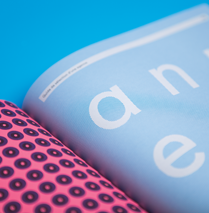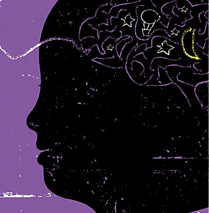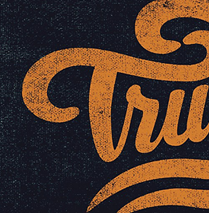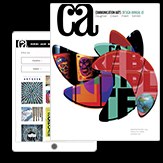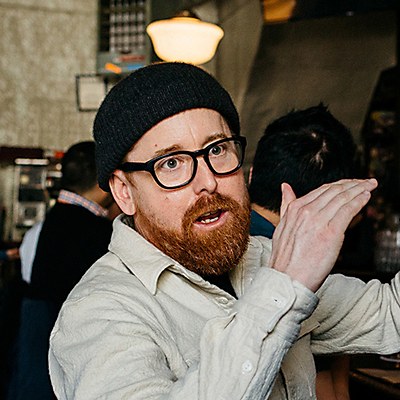How did you discover your interest in typography and learn the necessary skills to get started in the field? I discovered typography during my undergraduate studies at the National Institute of Design in India where I started on a project to create a typeface for the unstandardized Tulu-Tigalari script, traditionally used around the southwest of India. This effort opened my eyes to the vast ocean of language and script. At that time, I had no compass to guide me through, even at a premier institute like the National Institute of Design. Knowledge of Indian scripts was very limited. Despite resource constraints, I pursued this project even after my graduation, visiting archives and restoring palm leaf manuscripts with the generous help of the National Mission for Manuscripts, an Indian governmental organization.
I taught myself to read the Tulu-Tigalari script and began to understand the intricate nuances of the various scribal practices in the script system. Its linguistic aspects also had to be understood and analyzed, in addition to carefully constructing the historical narrative around this script from the primary sources. This then led to my involvement in the Unicode encoding of Tulu-Tigalari, with valuable assistance on technical aspects from digital paleographist Vinodh Rajan. To deepen my understanding, I pursued an MA in typeface design from the University of Reading in the United Kingdom, renowned for its research-oriented approach and expertise in global script systems. The Felix scholarship generously supported my education and enabled me to refine my skills. Eventually, I produced a release-ready font after years of hands-on experience as a freelance type designer.
What do you do in your role as Monotype’s first creative type director in India, and what do you enjoy about it? 2024 is the 60th anniversary of Marshall McLuhan’s assertion: “The medium is the message.” However, it still resonates deeply with my work at Monotype. Just as McLuhan proposed that the medium itself has a profound impact on how the content is received, we at Monotype share our expertise in making communication accessible, impactful and enjoyable through skillful use of well-designed typefaces.
As Monotype’s first creative type director in India, my role involves overseeing the design and development of typefaces for the Indian market. This includes understanding the needs of this region and expanding our library to best suit this. Including working on custom typefaces in regional scripts, collaborating with foundries globally and providing technical support to clients using non-Latin scripts. I enjoy the opportunity to extend the heritage of ancient language systems by carefully interpreting them within the current technological ecosystem. This role lets me support brands in developing unique voices that resonate with diverse audiences.
Tell us about some of the fonts you’ve worked on throughout your career. What briefs or problems did they fulfill, and how did you engage in the necessary research to create them? I have primarily focused my efforts on creating workhorse typefaces for various foundries and platforms, especially in Devanagari, Kannada, Malayalam and Telugu scripts. One notable project is the Akaya typeface for Google Fonts. Designed for Kannada, Latin and Telugu, Akaya emerged from extensive research into historical South Indian script systems. The limited presence of calligraphy in their older handwritten styles was quite apparent to me, which inspired me to explore a contemporary calligraphic style that could harmonize the modern aesthetics of Kannada and Telugu scripts and translate into a typeface. The Akaya typeface captures a unique informal display style that I observed in several hand-painted signs, book covers and banners across the Kannada- and Telugu-speaking regions. I collaborated with designer Juan Luis Blanco to create the matching Akaya Latin. Carefully constructing the letters based on the Kannada and Telugu designs I’d shared, Blanco began his design by challenging traditional rules related to contrast and stress, which resulted in a reverse ductus approach for constructing the Akaya Latin.
Some day, I would like to take a closer look at the various calligraphic styles that emerged in South India after the introduction of printing.
Personally, I’m excited to see the rise of multiscript families used for communications in multiple languages, especially with non-Latin scripts. How have you seen brand attitudes toward multiscript families in India change recently? I completely agree; I’m quite excited about this remarkable shift too. Technological advances like touchscreen keyboards and Unicode support with OpenType font formats have been its key enablers. These greatly simplified digital access to various complex scripts. As more people interact in their native languages and even dialects, having fonts that support the intricate details of various language systems that use the same script has become crucial—more so as they appear across popular social media platforms.
Tier 2 and Tier 3 markets in India are known for their preference for communicating in regional languages and dialects and are comfortable reading in their native scripts, as opposed to Latin and English dominating in Tier 1 cities in India. It is pertinent that Tier 2 and Tier 3 cities in India contributed to nearly 63 percent of all online orders placed in the country in the recent years. With brands targeting this large market, there is definitely a need for them to translate their presence into regional scripts. Having multiscript font families simplifies this process, enabling the brand personality and message easily adapt to various languages and scripts.
When developing a multiscript family, how do you ensure it stays true to the cultural context of its readers and writers? Scripts are fascinating entities. Even in their printed form, they evolve subtly, mirroring contemporary trends and sociocultural shifts. It is therefore essential to keep a finger on the pulse of each language system and understand the ways in which the script is used within that context. While working on a multiscript typeface, having experts for each script system therefore becomes important.
The intention of several multiscript typefaces today is to closely match the visual harmony across scripts by matching the style of one script to another. Using a multiscript typeface created with sensitivity ensures consistent expression of the intended message’s personality across different scripts, maintaining a unified visual style. This also facilitates visual cohesion between script systems and makes it easier to apply a similar typographic layout and design language, which are particularly valuable for maintaining the visual cohesion of a global brand.
Aside from being a type designer and lettering artist, you’re a conservationist as well. Has your passion for scuba diving and ocean conservation influenced your work? Everything is interconnected. The patience required to design a typeface is mirrored by the patience I need while teaching people to scuba dive. The tranquility of the ocean, experienced over a few thousand dives, remains with me and enriches my creative process when designing typefaces. Caring for old manuscripts, revitalizing scripts, guiding people, and shaping letters and languages are all driven by the same respect I have for history as I have for nature—an engagement with the continuum of life. I’ve discovered that the deeper you dive, the more enjoyable it becomes.
What is your biggest challenge as a type designer? The Indian font market is currently inundated with pirated or substandard fonts. Crafting premium Indic fonts is an endeavor that demands significant time and resources, and until recently, it lacked substantial financial backing. However, a paradigm shift is underway. I hark back to my earlier reference to McLuhan’s quote. Indian marketers are beginning to appreciate the role of typeface design and typography in brand personality and undergoing the quest for a consistent visual messaging across media. A small investment in fonts drives up the perceived value of brands along with a marked increase in engagement.
At Monotype, we are dedicated to cultivating a sophisticated understanding of font licensing and the intellectual property rights of creative professionals. In line with this commitment, we are looking to partner with design schools to initiate in-depth discussions on these pivotal topics. We want to enlighten and empower emerging designers and equip them with the knowledge to adeptly navigate the intricacies of font licensing and intellectual property.
What is your dream design project at the moment? There is a list of projects I have been dreaming about. Toward the top would be the creation of educational platforms and communities designed specifically for Tier 2 and Tier 3 regions in India with an aim to make language technologies accessible to everyday users, providing these communities with the essential tools and knowledge to not just survive, but to thrive in a digital world—to empower individuals, giving them the ability to shape their engagement in this rapidly evolving landscape from an informed, well-supported perspective. It is a vision of inclusivity and progress that I would love to participate in.
What advice would you give type designers just entering the field today? Be curious and embrace fearlessness in your explorations of various scripts, subjects and technologies. Delve into every facet of the craft, from its roots to its many branches. Generously share your insights along the way for this subject is vast as the ocean, always full of new mysteries to uncover. Don’t hesitate to ask for help, as this field is filled with not just the most skilled people but also the most helpful people. ca



